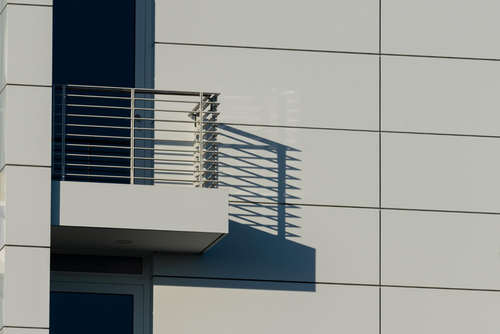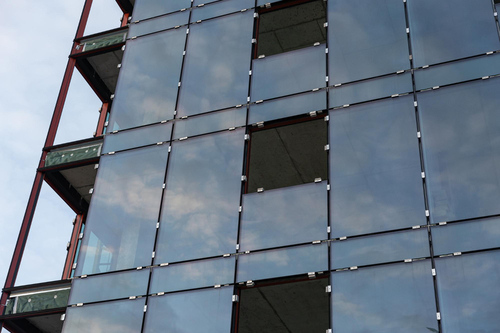Modern architecture is not only about beauty, but also about performance. The exterior skin of a building not only determines its aesthetic value but also safeguards it against weather, improves energy performance, and extends its lifespan. Here is where architectural facade systems come into the picture.
These high-tech exterior solutions are more than just cladding; they provide structural stability, insulation, and sustainability, while also allowing designers to express their creativity.
Whether it is the enduring natural stone or the innovative solar panel facade technology, the materials and engineering of modern facades are transforming the way buildings interact with their environment. As the demand increases for environmentally friendly and long-lasting solutions, the market for advanced building facade systems evolves rapidly.
What Are Architectural Facade Systems?
An architectural facade system is an external envelope of a building; it gives both functional and decorative advantages. It serves as a separator between interior areas and the outside world, protecting occupants from rain, wind, and changes in temperature. Simultaneously, it helps to form the visual identity of the building, which defines the general design.
Modern facade panel systems are designed to perform better than traditional cladding. They are created to be more energy efficient, have fewer maintenance requirements, and meet higher sustainability standards.
What Are the Main Types of Facade Systems?

When selecting the right solution for a project, it is essential to understand the different facade system types. The categories are used differently, and they are most effective when applied in specific conditions.
Non-Ventilated and Ventilated Facade Systems
Ventilated facade systems, commonly known as rainscreen facades, create an air space between the cladding and the building structure. This enhances thermal insulation, reduces condensation, and increases the lifespan of the materials. Conversely, non-ventilated systems are connected to the building envelope, which is a less technical, and often less expensive, method.
The ventilated designs are gaining popularity among architects due to their high energy efficiency. According to a report, “Ventilated facade systems are indeed gaining traction in the construction industry, with projections indicating they will account for over 40% of new facade installations by 2028” (WiseGuy Reports).
These building facade systems help control internal temperatures, thereby minimizing the need for HVAC systems. Conversely, non-ventilated facades may be more suitable for smaller-scale buildings where cost is a primary concern.
Types of Curtain Wall vs. Rainscreen Facade
Curtain walls are non-structural walls that provide a modern, sleek appearance with extensive glazing. They are usually found in commercial towers where there is a priority on natural light. In the meantime, rainscreen systems are ideal in areas that receive a lot of rainfall, as they divert water away from the building.
These two kinds of facade systems can be integrated with other materials, such as aluminum or ceramic facade systems, to achieve a specific design vision. The decision is finally based on the preferred aesthetics, thermal performance and maintenance needs.
Exploring Modern Facade Materials

One of the most characteristic features of any facade project is material selection. Modern architectural facade systems offer a wide range of finishes that not only enhance the visual impression but also improve the technical performance of the building.
Aluminum Facade Systems
Aluminum facade systems are known for their lightweight and durable nature. They are non-corrosive and therefore suited to urban areas where pollution and weathering are ever-present problems. Aluminum panels can also be moulded into several profiles, which allows the architect to play with dynamic shapes and textures.
The second benefit of aluminum as a facade material is its recyclability, which does not compromise design flexibility as sustainability objectives are pursued. They can also be easily combined with other elements, such as glass or composite materials, to provide a modern yet practical look.
Ceramic Facade Systems
The systems of ceramic facade add extraordinary durability and a high-end finishing to the exterior of buildings. The sintered ceramic panels are UV, graffiti, and temperature-resistant, providing a low-maintenance solution for busy urban environments. They have a non-porous surface that guarantees colour stability over a long period and still maintains a premium look.
A ceramic facade is also an ecologically friendly choice, as it is made from natural raw materials and promotes a long service life. This decreases the necessity of regular replacements, which also lowers the environmental impact of a project.
Natural Stone Facade Systems
Few materials can match the timeless elegance of natural stone. The texture and depth of a natural stone facade system are the first things that enhance the character of any building. Modern stone facades are lightweight and simpler to install than masonry.
Contemporary methods of fabrication enable the cutting of stone panels thin without sacrificing their natural strength. This increases the flexibility of natural stone facade solutions and also makes them compatible with other materials like glass or metal. Not only do they exude an elegant look, but they also age well, remaining beautiful even after decades.
Solar Panels Facade Systems
With sustainability being a primary consideration in the construction process, solar panel facade systems are becoming a clever alternative to clean energy production without sacrificing design. These new surfaces, often referred to as solar facade systems, incorporate photovoltaic technology as part of the building envelope.
These vertical solar installations differ from conventional rooftop solar panels as they utilize idle wall space, which also contributes to overall energy production. Modern photovoltaic facade systems are available in various finishes, enabling architects to maintain consistency in their aesthetic while pursuing net-zero objectives. They also make buildings better insulated, which increases energy efficiency even more.
Sustainable Innovation in Facade Design
The future of facades lies in striking a balance between design freedom and sustainability. The developers are becoming increasingly inclined towards materials and technologies that minimize carbon footprint and contribute to green building certifications. A good example is the incorporation of solar panel facade technology, which converts sunlight into electricity while also serving as a weatherproof shield.
Technologies like the BIPV facade system, offering a combination of renewable energy and the luxury of design, are the future of architectural exteriors.
How Can You Choose the Right Facade Panel System?
The choice of the optimal facade panel system is determined by several factors that affect the performance and the appearance:
- Climate and Environment: In extreme weather conditions, long-lasting systems such as ceramic facade systems or aluminum facade systems are best suited to provide long-term protection.
- Building Type and Scale: Ventilated designs can be useful in large commercial buildings, but smaller projects may prefer simpler, non-ventilated types of facade systems.
- Energy Efficiency Goals: In the case of a sustainable project, renewable energy can be produced with a solar panel facade system or a BIPV facade system technology, which also enhances insulation.
- Aesthetic Needs: In case of a natural, timeless appearance, natural stone facade solutions are the best option, whereas a sleek urban appearance is more likely to be achieved with an aluminum or ceramic facade.
- Maintenance and Longevity: Low-maintenance materials, such as ceramics or engineered stone, lower the costs of long-term building maintenance, and the building will remain beautiful even after many decades.
A properly designed facade is not only a visual improvement of the building, but also a shield to the building, a better energy performance, and long-term sustainability. This is why integrated systems, such as those developed by Elemex, have gained the trust of both architects and developers.
Why Elemex Architectural Facade Systems Stand Out

Elemex architectural facade systems are designed to provide beauty and performance. These solutions are supported by proprietary Unity attachment technology that guarantees easy installation and outstanding durability.
At Elemex, we have a broad variety of materials to meet various architectural visions. Ceramic facade systems, such as Ceramitex, offer unsurpassed weathering resistance, whereas aluminum facade systems, such as Alumitex, offer a sleek, modern appearance. Solstex is designed to incorporate the technology of solar panel facade systems directly into the building envelope, so it is more suited to people who value sustainability.
All systems are checked to ensure they comply with North American building codes, ensuring reliability in the long run. With a combination of high-performance engineering and a modern aesthetic, Elemex helps architects bring their creative visions to life while also meeting environmental requirements.
Future Trends in Architectural Facade Systems
Facades will no longer be fixed in their designs in the years to come. Adaptive smart materials are already coming into the market. Dynamic systems enable the control of shading, ventilation, and even power generation, taking architectural facade systems a step further.
The trend of using photovoltaic facade systems is expected to persist, as cities strive to achieve net-zero emissions. Simultaneously, hybrid materials combining the durability of aluminum facade with ceramic finishes or combining the technology of BIPV facade systems will gain popularity. Architects will continue to seek solutions that do not compromise aesthetics, performance, and sustainability.
Final Thoughts
The facade of an architectural building has always been the most apparent aspect of a building, but nowadays, it is also the focus of performance, sustainability, and occupant comfort. Whether it is the grace of natural stone facade solutions or the high-tech innovation of the solar panel facade systems, the variety of choices has never been greater.
Are you ready to revolutionize your next project by using new facade solutions? Contact us now to discover how we can bring your architectural ideas to life.

